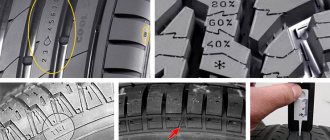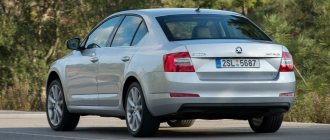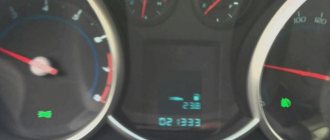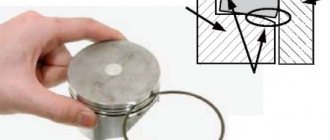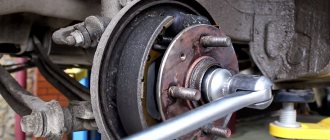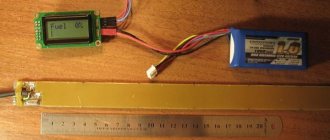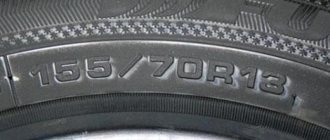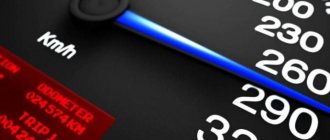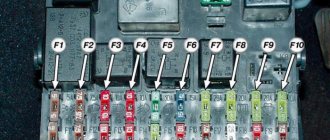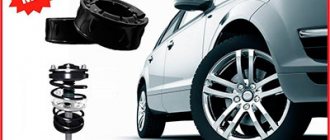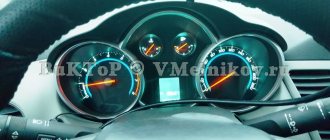What are the dangers of tire wear?
Many drivers pay attention to the condition of their tires only in winter. Slippery roads cause frequent accidents, so motorists change their car in time. In the summer, when the road is dry, many people believe that using worn tires will not bring any danger. They are very wrong. Using old tires is dangerous at any time of the year and in any weather. Let's look at some of the implications of this:
- The car becomes uncontrollable.
- The braking distance of the car increases, and this can lead to a traffic accident.
- Hydroplaning occurs - as a result of the appearance of a water layer between the road surface and the car, traction with the road is completely or partially lost.
- The car may turn around unexpectedly, then an accident cannot be avoided.
- If tires wear unevenly and pressure increases, a rubber explosion may occur.
Driving on bald tires is prohibited at any time of the year. In case of violation, drivers face a fine of 500 rubles or a warning.
Low pressure
Not only different, but also low pressure can lead to a decrease in the service life of the purchased tire. This is due to the fact that tire manufacturers create designs taking into account recommended operating conditions. If you operate the wheels with low pressure, they begin to wear out quickly. In this case, the load will fall on the part that is not intended for this.
A low pressure indicator determines the following:
- The structure begins to sag at the edges.
- The rim may come into contact with the tire surface, which will increase wear.
However, high pressure also causes eating to begin in the central part.
That is why you should constantly pay attention to what the pressure is. It is worth inflating the wheels to the level recommended by the manufacturer.
How to tell if a tire is worn out or not
Most evaluation methods are available to the average user, although not all of them.
Tire appearance
A lot can be appreciated visually. For example, the color of rubber loses its saturation over time, and tires become characteristically whitish. This is a good sign that aging has occurred due to oxidation of the tire material.
Mechanical damage is also visible, both natural in the form of age-related cracks and delamination, and artificial, traces of numerous repairs, exposure of the cord due to cuts, convexity of the profile under pressure (bumps).
Uneven tread wear in the form of saw-tooth or bald spots is clearly visible. Such a wheel is dangerous when braking.
Profile depth measurement
To estimate the actual residual value, it is necessary to know the original tread size, as well as the minimum allowable for a particular tire model. A big mistake that sellers most often intentionally make is to calculate percentages based on absolute depth.
The tire cannot be used until it is completely worn out. Moreover, based on its intended purpose, rubber can completely lose its properties even with a sufficiently deep pattern.
This applies to winter, mud and all-season tires. They must effectively remove the soft component of the road surface from the contact zone, which is only possible with a sufficiently deep tread.
Digital indexes on the protectors
This is the most convenient way to determine wear, built into the tire design by the manufacturer. The tread rubber has indentations in the form of numbers, which disappear as the rubber wears off. The largest of the remaining ones determines the resource height of the relief.
Other indications are also possible; all types are simple and as intuitive as possible.
This is interesting: How and how to glue molding on a car door
To the extent that some manufacturers use color indication, when rubber of a different shade is embedded in the depth of the tread. A worn treadmill will then change its color to one that contrasts with the other surface.
Handy methods
Although it is almost impossible to find modern tires without wear indicators at all, the old methods continue to work. Between the blocks or tread tracks you can place a caliper depth gauge, which will show the remaining depth in millimeters.
All that remains is to subtract the minimum acceptable value from the resulting number. If you don't have a caliper, you can use a ruler, or even just a coin.
Why is it important to know your tire wear?
The main characteristics of car tires are provided by a convex pattern applied to their surface - the tread. Thanks to the tread, a contact patch between the tire and the road tread is formed, the wheel’s engagement with the road is ensured, and most importantly, the tread removes water, dirt and slush from under the wheel, ensuring better contact with the road surface.
However, rubber is constantly subject to wear, so over time the tread wears out and its height decreases. This entails a number of negative consequences, including a decrease in the speed at which “aquaplaning” begins, deterioration in controllability, an increase in the likelihood of skidding, etc., and wear on the tread of trucks and tractors also reduces the cross-country ability of these vehicles. Ultimately, excessive tire wear reduces vehicle safety and can cause an accident.
Therefore, tread height is strictly regulated by law, and every driver must comply with the established tire wear requirements. The remaining tread height, upon reaching which the tires can no longer be used, is established by paragraph 5 of the “List of faults and conditions under which the operation of vehicles is prohibited,” which is an appendix to the traffic regulations.
- Tire CORDIANT Business CA
4 250 ₽
- Tire Forward Professional 156 AShK tubeless
2 990 ₽
- Tire VIATTI Brina Nordico V-522 stud.
2 650 ₽
- Tire LTA-401 Rosava
6 890 ₽
- NOKIAN Nordman 5 stud tire.
3 120 ₽
- U-2 Nizhnekamsk 10-ply tire with tube
7 450 ₽
- Tire SATOYA SU-022 with tube and ob. tape
8 790 ₽
Traffic regulations
One of the key characteristics that is responsible for vehicle controllability and stability on the road is the tire tread height. Sometimes it is not possible to objectively assess this indicator by eye. In this case, a special indicator that is integrated into the rubber by the manufacturer will not help. It is the tread that provides high-quality traction between the wheel and the road surface, and it is especially important to monitor its degree of wear in bad weather. During and after rain, snow, and ice, the vehicle's contact with the road deteriorates significantly.
The traffic rules, for their part, regulate what the degree of wear should be, and clear quantitative indicators are provided for this:
- passenger cars - 1.6 mm;
- motorcycles - 0.8 mm;
- buses - 2 mm;
- trucks – 1 mm.
And in order to assess the tread height, we just need an indicator indicating tire wear. It is a part of the tread that differs in position, shape and size from the rest of the tire pattern. Most often, such an indicator is volumetric and placed in a groove. Another option is a digital beacon in the form of digital markings at different depths.
The collapse of convergence
Eating may occur on the inside or outside due to the incorrect location of the wheels relative to the vehicle body. In this case, after a long time, severe abrasion can occur on either side. When considering such a problem, the following nuances should be noted:
- Camber is an indicator that is responsible for the tilt along the vertical axis.
- Toe is an indicator that is responsible for the position of the wheel when turning.
Such indicators apply only to the front axle. What can seriously eat up the wheels after a few kilometers of travel?
If you change the wheel alignment settings, the cord wears out. At the same time, it eats the cord differently, depending on how the set parameters were reset. After a few hundred kilometers, the problem can manifest itself clearly, up to complete wear of the tread to the base of the cord.
Considering this question, we note the following:
- If it eats the inner side, then this indicates an excessive inward tilt. This situation is called negative camber. This situation occurs quite often.
- If the outer edge wears quickly, then this is positive wear. In this case, the wheels are tilted in different directions.
After 300-500 kilometers of travel, even a new tire can become completely unusable. However, it is worth considering that zero camber leads to uniform, but increased wear. This situation also leads to a significant increase in fuel consumption, and also increases rolling resistance.
The settings are reset for the following reasons:
- Due to prolonged use of the vehicle without proper maintenance.
The alignment condition should be checked periodically. Long-term operation of the car on bad roads, which causes constant exposure to various loads, necessarily leads to changes in settings. - If there is a strong impact while driving. Often, when hitting a curb or other serious obstacles, the alignment indicators change. Therefore, after such contact at high speed, the wheel alignment indicator should be checked.
- When carrying out any work related to the front suspension of the car. Carrying out repair work leads to the settings being lost. However, not all works cause this phenomenon.
- If important suspension elements are defective. Severe wear of the suspension elements also leads to the wheels being at the wrong angle to the body.
Checking the wheel alignment at a service station takes a little time. Modern equipment allows you to perform a quick and accurate alignment check. Experienced craftsmen perform the work of setting the required parameters within a short time.
Main types of indicators
The simplest is a volumetric type determinant, which functions simply and clearly. As the tread wears off, it begins to compare with the height at which the beacon is located. This means that the tire must be replaced. Today, manufacturers equip tires with not only the main indicators, but also intermediate ones, so that the driver can monitor the wear of the pattern in advance and prepare for replacement.
We recommend: Get income from your car
The digital indicator on the tires looks somewhat different. Represents numbers extruded into the tire at a certain depth. The smallest number (usually 2) is at the greatest depth and vice versa. During operation, the tread will wear out, and the numbers themselves, accordingly, will disappear. As soon as the last one disappears, it means that the rubber has reached a critical level of wear. It is digital beacons that have become most widespread for the reason that they do not need to be deciphered, and even a child can understand their meaning.
Types of tread wear - what malfunctions do uneven wear indicate?
It is important to know what types of problems there are. The tire may have normal/normal wear. In this case, the tread wears out approximately evenly, with minor nuances related to the installation location; the level of abrasion for the front and rear axles is always different. Such damage appears at high mileage and is the norm. You can determine the natural wear of a tire using indicators; they show the need to replace the tires.
Below we will consider the types of wear that are the result of various breakdowns and other reasons.
- Wear of the shoulder areas, both sided and symmetrical. Characterized by uniform wear of the tread along the edges of the slope. The reason is incorrectly selected wheel size, incorrectly selected air pressure, increased load. The reason may be single or complex.
- Erase in the center of the slope. In such a situation, we can talk about poor contact of the tire with the coating. In this case, the wheel is less controllable. Occurs when the tire is overinflated.
- Diagonal dent in tread. Often combined with obvious signs of erasing the design. Occurs when the vehicle is constantly overloaded. More often found on the rear axles of front-wheel drive vehicles.
- Convex wear on the shoulder blocks. It's not easy to notice. It is characterized by uneven erasure of the block, one part is reduced, the other remains almost intact. This can only be noticed by touch. This happens when the ball joints and wheel bearings are damaged.
- Single spots. It occurs most often on cars without ABS. When braking or maneuvering sharply, the wheels lock, resulting in a short ride on the tire, like on a ski. At this moment it is erased in one place. It is not easy to notice such problems. After each lock-up braking, inspect the wheels.
- Flat spot. This is deformation of the tire in one place. Appears after a long period of parking.
- One-sided tire wear. Appears as a result of improper wheel alignment. As a result, the tire receives an uneven load, which leads to this problem. Moreover, erasing occurs quickly; sometimes it is enough to drive 10-20 km to completely erase the edge. Sometimes it can appear when the load is unevenly placed.
- Dents on sides and tread. It looks like bumps and small dents all over the tire. Occurs when the suspension is faulty, as a result of a large number of impacts of varying degrees of force. This usually happens due to faulty shock absorbers.
- Hernias and cracks. These are bulges and linear damage to the tire. Occurs during side impacts on the tire. Sometimes they can be a consequence of operation with low pressure, or simply due to the aging of the material.
There are many types of damage; knowing what they look like, you can diagnose the problem in a timely manner.
Types of tire wear indicator
Despite the fact that the wear indicator of different brands of treads looks different, one thing remains the same:
- the indicator is made of the same rubber as the tire;
- The height of the indicator never falls below 1.6 mm.
In principle, for all tire brands, four types of wear indicators are most often found:
- in the form of a cord-shaped straight transverse “influx” relative to the tread grooves;
- in the form of volumetric numbers (usually the numbers are set from 2 to 8), standing out in relief against the background of the surface of the tread blocks;
- in the form of a symbol - for example, a drop of water (this designation is always adjacent to the digital designation of the tread thickness!);
- in the form of a change in the original tread color.
Tire aging
Even though rubber typically wears out before it reaches its expiration date, there are certain deadlines. Aging rubber can cause it to wear unevenly and severely. It is also worth noting that improper storage can lead to rapid aging of rubber.
All manufacturers indicate how long a product can last under certain operating conditions. It also indicates how it should be stored.
Aging of rubber leads to the fact that it loses its tightness and the structure becomes porous. After some time, moisture begins to penetrate deep into the structure. As a rule, manufacturers use metal cord to strengthen the structure. Moisture leads to the destruction of the metal base. According to accepted standards, a tire cannot be used after 10 years from the date of its manufacture.
Where is the indicator located on the tire?
Most often, a tire wear level indicator (it may be absent on winter models!) is installed at the bottom of the tread groove: this is logically justified from the point of view of its gradual wear.
Visually, such a signaling device looks like a kind of “fused-on” column connecting two or three (sometimes four) tread “checkers” of different heights.
If you have difficulty finding the indicator, you can always clarify its location by examining the markings on the side of the tire.
If the tire wear indicator is made in the form of a change in their color, then, of course, there will be no grooves or raised numbers on the tread, since the tread itself consists of two multi-colored layers. During operation, the first layer of optimal driving thickness gradually wears off, and in its place a deeper layer of a different, contrasting color appears.
Tire wear index
Each manufacturer indicates a so-called wear index on the tire profile, which most often looks like the inscription “Treadwear 100” and means a maximum of 48,000 km on a standard road surface (test site). In a real environment and often not the most ideal roads, this number actually needs to be divided by 1.5 - we get 36,000 km.
By analogy, if the wear resistance index is 150, then this means “factory” 72 thousand km, 200 – 96 thousand km, and so on.
Why are worn tires dangerous on the road?
- adhesion to the road surface deteriorates, which leads to an increased likelihood of skidding, accidents, and aquaplaning in the event of rainy weather;
- cross-country ability in off-road conditions decreases;
- the risk of a tire puncture while driving increases.
It is also worth remembering that the issue of tire wear is regulated by traffic rules, and you can get a fine for using “bald” tires. Knowing what maximum tire wear is permissible, this can easily be avoided: 1.5-2 mm for summer ones, and 4-5 mm for winter ones (a more accurate figure is indicated by the manufacturer).
Uneven tire wear: how to determine, reasons, dangers
If measurements show different results in different parts of the tread, it is important to determine exactly how your tires are wearing in order to understand where and what the operating error is.
If the tread is more worn on the sides and less worn in the center, this means that the tire pressure is insufficient and the contact patch with the road is not correct. This leads not only to poor vehicle stability, but also to increased fuel consumption.
If the tread is worn down in the middle but the sides are fine, this means your tires are overinflated. Sometimes this is done deliberately in order to save fuel, but in this case the tires will still have to be changed ahead of schedule.
There is also the possibility of increased wear on the inner or outer side of the tread - this signals improper wheel camber. A visual table with wear options and its causes:
We carry out an inspection
The characteristics of the vehicle determine which side wears more heavily: the rear or the front. In order to assess not only the suitability of the tires, but also to determine the absence of problems with the technical condition of the car, you should inspect all 4 wheels.
Let us note:
- In a car that has a rear driven axle, it is the rear wheels that will wear out more; in a front-wheel drive car, on the contrary, the front wheels will wear out. This is due to the fact that the transmission of torque leads to an increase in the friction force between the wheel and the road.
- If, for example, a Fiat Albea has disc brakes at the front and drum brakes at the rear, the front wheels will wear out more. This is due to the fact that disc brakes are more efficient. Often, severe abrasion of one or another part of the wheel occurs during braking, since at this moment there is a large load on the axle.
Driving style always determines the degree and speed of wear. The more acceleration and braking while driving, the greater the wear.
When inspecting, it is worth considering that the cases under consideration determine uniform wear over the entire surface. Why is it eating rubber unevenly? The answer is quite simple - there is a malfunction that leads to this.
It is possible to determine whether the wheels are more eaten up on the inside or outside only after a fairly long period of time. This is due to the fact that only after several hundred kilometers it will become visible without the use of special instruments to measure the tread size.
How to visually assess tire wear: additional parameters
- Cracks on the sides of tires may indicate frequent off-road driving, improper storage, poor-quality rubber or long service life, as well as incorrect tire pressure.
- Bulges or “hernias” on the sides of tires are caused by the side of the tire hitting hard obstacles. Tires with such damage are not recommended for use.
- Dents on the tread indicate insufficient shock absorption and unadjusted wheel alignment. Having discovered such damage, it is necessary to take the car to a service center and make sure that the suspension is in good condition.
- Individual wear spots on the tread indicate aggressive driving/braking, skidding with wheel locking, or prolonged parking of the vehicle in one position.
Common problems
When considering why the Fiat Albea has tires with varying degrees of wear, it should be noted that in some cases the problem manifests itself after several hundred kilometers of travel. Let us highlight the following reasons why rubber is consumed unevenly:
Incorrect alignment, which can occur after some time of operation of the vehicle and with a strong impact. Internal wear often occurs for this reason. Therefore, many people pay attention to it when checking the tread.- Incorrect tire pressure can also be cited as the reason why wear occurs on the inner or outer side after some time.
- Low pressure can also cause uneven wear. Those who like to ride on flat tires constantly change their tires.
- Defects in manufacturing. It is quite rare to encounter a situation where the cause of the phenomenon in question is a manufacturing defect. That is why you should pay attention when choosing to offer only trusted manufacturers.
- Tire aging. It is quite rare for tires to be used after they have been manufactured for several years. This is due to the fact that a large number of cars determines a high need for the product in question. Therefore, all tires are bought up quite quickly.
There are quite a lot of answers about what is eating rubber. A Fiat or other car should be checked according to a certain scheme to identify the problem. This is due to the fact that even a simple reason that takes little time and effort to eliminate can lead to significant problems.
How to calculate tire wear as a percentage
Most often, this is required for the sale and purchase of used tires, in order to orient the buyer to the degree of wear. Many sellers give this figure at random, but this method has nothing to do with a real assessment of the degree of wear of the tire. It is also important to understand that a conditional 50% wear for a summer tire is an acceptable value, while 50% wear on the tread of winter tires is a sign that the tire cannot be used. Therefore, it is important to know how to accurately determine the percentage of tire wear in order to avoid getting into an unpleasant situation.
Many people divide the actual tread height by the height of the same, but new tire, and get a certain percentage of wear. This would be correct, if not for one BUT: we cannot physically erase the tread to zero, and the law prohibits the use of tires with a tread below the permitted values.
You can calculate actual tire wear by dividing the difference between the height of the new tire and the actual height by the difference between the tread height of the new tire and the minimum possible tread height for that tire, and then multiplying that number by 100.
If you cannot find out the height of the same, but new tire, use the average values of your tire type:
We recommend: Where you can buy a car in Nizhny Novgorod
| Tire type | Average tread height at start of use |
| Winter tires with Scandinavian tread | 10 mm |
| Winter with regular or asymmetric tread | 9 mm |
| High-speed winter | 7 mm |
| Summer tires with classic tread | 8 mm |
| Summer expressways | 7 mm |
You can check summer tires for wear a little less often than winter ones, since in the summer the tread depth is not so important for cross-country ability.
If you have assessed the condition of your tires based on all of the above factors and realized that the tires are worn out, be sure to replace them with new ones as soon as possible.
Legislative framework of the Russian Federation
not valid Edition from 04.07.1998
detailed information
| Name of document | “METHODOLOGICAL GUIDE TO DETERMINING THE COST OF MOTOR VEHICLES, TAKEN INTO ACCOUNT OF NATURAL WEAR AND TECHNICAL CONDITION AT THE TIME OF PRESENTATION. RD 37.009.015-98" (approved by the Ministry of Economy of the Russian Federation 04.07.98) |
| Document type | methodological manual |
| Receiving authority | Ministry of Economy of the Russian Federation |
| Document Number | RD 37.009.015-98 |
| Acceptance date | 01.01.1970 |
| Revision date | 04.07.1998 |
| Date of registration with the Ministry of Justice | 01.01.1970 |
| Status | It does not work |
| Publication |
|
| Navigator | Notes |
“METHODOLOGICAL GUIDE TO DETERMINING THE COST OF MOTOR VEHICLES, TAKEN INTO ACCOUNT OF NATURAL WEAR AND TECHNICAL CONDITION AT THE TIME OF PRESENTATION. RD 37.009.015-98" (approved by the Ministry of Economy of the Russian Federation 04.07.98)
Appendix P. METHOD FOR DETERMINING THE PERCENTAGE OF WEAR OF VEHICLE TIRES
<*> The method has been agreed upon with the Research Institute of the Tire Industry of the Ministry of Petroleum and Chemical Industry.
P.1. Tire wear (aging) criteria are:
— presence of damages and defects;
- lifetime;
— tread pattern height.
P.2. The tire life is reduced, and the percentage of wear increases accordingly:
— if the board is damaged during installation, up to 10%;
— if spalling, chips, cracks on the tread or cracks and wear of the sidewall without exposing the cord are detected, up to 20%;
— if local wear (spotting) of the tread is detected, up to 25%.
Note. Tires with carcass delamination are considered 100% worn.
P.3. To the percentage of wear determined by technical condition, the percentage of wear (aging) over the service life of the tire is added.
Over three years of operation, a tire loses up to 10% of its service life due to aging, in proportion to its service life.
In the interval from 3 to 5 years, tire aging increases to 25%. A tire with a service life of more than 5 years can reach an estimated wear percentage of 50%.
The service life is determined by the date of manufacture in accordance with the factory marking in accordance with GOST 4754-80.
P.4. The tire tread life is characterized by its height on a new tire (Vn) (see Table 9) minus the minimum permissible remaining tread height (Vdop), at which the tire must be removed from service (for passenger car tires - 1.6 mm, for trucks - 1.0 mm, buses - 2.0 mm, motorcycle tires - 0.8 mm).
P.5. The residual (actual) height of the tire tread pattern (Vph) is determined as the arithmetic mean of the heights measured in 4 mutually perpendicular sections of the tire around the circumference. It is more expedient to make such measurements in the planes of the natural symmetry of the wheel. In each section, the height of the pattern is determined by the area of the treadmill that has the maximum wear.
P.6. The percentage of tire wear by tread height is calculated using the formula:
| Ish = | (Vn - Vf) | x 100%. |
| (Vn - Vdop) |
P.7. For tires with 100% tread wear, but suitable for retreading, the cost is set equal to the deposit price of the tire to be retreaded, which on average is 0.03% of the cost of a new tire.
P.8. For tires that are unsuitable for further use and retreading, conditional wear is set at 100%, and the cost is equal to the cost of recycled materials.
P.9. The wear of tires restored by applying a new tread is determined by the method described above, while the nominal height of the updated tread pattern is taken to be 10 mm for passenger cars, 20 mm for trucks and buses, and the average cost of a retreaded tire is equal to the cost of restoration repairs plus a deposit the cost of a tire subject to retreading, which on average is 0.2% of the cost of a new tire.
Note. Motorcycle tires cannot be restored.
P.10. When calculating the wear of tubed tires, it is necessary to take into account the cost of the tire with the tube.
P.11. An example of calculating wear and cost of a tire.
Passenger car tire 165/80R13, service life 2 years, bead damaged during installation.
Damage to the bead during installation reduces the tire life by 10%.
The service life (2 years) of the tire increases wear by another 7% (in proportion to the service life from 10%).
Measuring the tread pattern height in 4 sections gave the following results:
| Vf = | 4,5 + 4,4 + 4,0 + 4,3 | = 4.3 mm, |
| 4,0 |
in this case, the tire wear along the tread pattern height will be:
| Ish = | (Vn - Vf) | x 100 = | 8,6 — 4,3 | x 100 = | 4,3 | x 100 = 61%. |
| (Vn - Vdop) | 8,6 — 1,6 | 7,0 |
Total wear:
| Ish = 10 + 7 + 61 = 78%. |
To take into account tire wear in the cost of the car, it is necessary to substitute the value Ish into the formula as one of the terms Itr. You can also separately calculate the cost of a tire by the percentage of its wear, i.e.:
| S'sh = Tssh (1 - | Ish | ) = Tssh x 0.22. |
| 100 |
P.12. Below are the tread heights for a number of tire models.
PASSENGER CAR TIRES
| Tire markings | Model <*> | Tread pattern height, mm |
| 155-13/6,15-13 | I-151, I-L143, I-L43 | 8,5 |
| 165-13/6,45-13 | M-145, AI-168, 168U | 9,2 |
| 165/80R13 | MI-166, MI-16 | 8,6 |
| 165/82R13 | IYA-170 | 8,5 |
| 175/R13 | IN-251 | 7,0 |
| 165/70R13 | Ex-85, Vli I-15 | 7,5 |
| 185-14/7,35-14 | ID-195, AID-23 | 9,5 |
| 5,60-5(145-380) | M-59A | 9,0 |
| 155/80R14 | MI-182 | 8,5 |
| 165/80R14 | MI-180 | 8,5 |
| 175/70R14 | MI-181 | 8,5 |
<*> For older tire models not included in the table, it is necessary first of all to determine the service life, and take the nominal tread height to be 10 mm.
TIRES FOR TRUCKS, BUSES
| Tire markings | Model | Tread pattern height, mm |
| 1 | 2 | 3 |
| 7.50-20 (TU 38104146-77) | Ya-151 | 15,5 |
| 220-508 (7,50-20) | MI-173 | 17,0 |
| 220-508 (7,50-20) | IYA112A | 15,0 |
| 220R-508R (7.50R20) | IYA-196 | 15,0 |
| 240-508 (8,25-20) | IK-6AM | 16,0 |
| 240R-508R (8.25R20) | K-55A | 18,0 |
| 240R-508R (8.25R20) | KI-63 | 18,0 |
| 260-508 (9,00-20) | I-252B | 20,0 |
| 260-508 (9,00-20) | I-249A | 18,0 |
| 260-508 (9,00-20) | MI-155 | 21,0 |
| 260R-508R (9.00R20) | I-N142B | 21,0 |
| 260R-508R (9.00R20) | MI-151 | 18,0 |
| 260-508 (10,00-20) | IVl-1A | 20,0 |
| 260R-508R (10.00R20) | OI-73B | 16,0 |
| 300-508 (11,00-20) | V-195A | 20,0 |
| 300R-508R (11.00R20) | I-68A | 20,0 |
| 300R-508R (11.00R20) | I-111A | 20,0 |
| 320-508 (12,00-20) | IYAV-12B | 22,0 |
| 320-508 (12,00-20) | IYA-241 | 15,0 |
| 320R-508R (12.00R20) | I-109B | 24,0 |
| 320R-508R (12.00R20) | I-A150, I-150A | 18,0 |
| 10.00-18 (TU 38104260-77) | K-65 | 20,0 |
| 320-457 (12,00-18) | K-70 | 20,0 |
| 320-508 (12,00-20) | M-93 | 25,0 |
| 370-508 (14,00-20) | OI-25, Ya-307, F-10A | 18,0 |
| Foreign tires | ||
| 220-508 (7.50-20) (TU 38104265-77) | Ex-20 | 15,3 |
| 240-508 (8.25-20) (TU 3810471-77) | Ex-20 | 16,3 |
| 260-508 (9.00-20) (TU 3810433-75) | Ex-20 | 18,5 |
| 320-508 (12.00-20) (TU 38104296-79) | Ex-20 | 23,0 |
| 260R-508R (9.00R20) (TU 38104301-80) | Ex-21 | 18,0 |
| 280R-508R (10.00R20) (TU 38104304-80) | Ex-21 | 18,5 |
| 300R-508R (11.00R20) (TU 38104302-80) | Ex-21 | 19,0 |
| 320R-508R (12.00R20) (TU 38104303-80) | Ex-21 | 20,0 |
| 370/80R508 (TU 38104211-79) | HP-54 | 21,0 |
| 1220X400-533 (TU 38104326-80) | I-P184 | 23,0 |
| 260R-508R (9.00R20) | Ex-12 | 14,0 |
| 260R-508R (9.00R20) | I-N190 | 18,0 |
| 280Р508 (10.00R20) | D-2M | 14,0 |
| 300R508 (11.00R20) | D-3M | 17,0 |
| 310/80R508 | D-1M | 16,0 |
| 310/80R508 | I-A232 | 21,0 |
| 255R572 (10R22.5) | U-1 | 18,0 |
| 1200X500-508 | ID-P-284 | 25,0 |
Types of tread wear indicators
Manufacturers solve the problem of label placement in different ways. First of all, they are located in different places.
- At the bottom of the grooves. This is the most common option.
- On tread blocks. Color identification is used here. It is not considered the most reliable method.
- On the sides. Primarily focused on the wear of shoulder blocks, it is often used on off-road tires.
Knowing where the indicator is located, it is much easier to find it.
In addition to location, there are different types of indicators. This must be taken into account so that you do not have to look for a non-existent mark.
- Tubercle. Usually located deep in the groove. Has the minimum height allowed for a specific type of tire. For summer tires the height will be 1.6 mm. The level of wear is easy to determine; if the groove is level with the tubercle, the tire should be replaced.
- Colored marks. The principle of operation is simple - to show that the tread block has worn down to a minimum value. Sometimes such indicators are erasable, in which case the mark is made to a certain depth. As soon as it disappears, it is worth changing the tires. Another option is a recessed mark; in this case, the colored mark appears only when the rubber before it is worn off, which indicates the tire has failed.
- Digital tags. They work similarly to color ones, but they use numerical values that tell you how much tread depth is left. Valued by drivers who often travel long distances. Also, such marks allow you to determine the time of changing tires between axles.
The location of the mark can be found by the triangle on the sidewall. It shows where the indicator is located on the tread.
Normal
Evenly worn tread indicates that the tires were stored correctly. This also serves as an indicator of the correct setup of the car's chassis. In addition to wear, it is also important to pay attention to the presence of microcracks.
Central
It indicates that the car is running on overinflated wheels. Since the rubber has become harder due to increased pressure, the wheel only adheres to the road in the central part.
Bilateral
This type of wear is typical for driving on low tires. In this case, the contact patch moves to the edges. The stiffeners are under load, and the rough road surface does its job.
Unilateral
This type of wear is typical for cars in which the axle geometry is incorrectly configured. If the tires wear more strongly on the inside, this indicates negative camber. External wear is a sign of positive wheel camber.
Low-quality rims can also be a problem. With strong impacts (a hole with sharp edges, a curb, etc.), it may become deformed, but this may not be noticeable from the outside.
Spots
This wear most often indicates improper wheel balancing. If balancing does not help fix the problem, you need to take the car to a service station to diagnose the suspension. The levers or damper struts may be faulty.
Sawtooth
For driving on loose and very wet soil, special tires are created - “alligator” or “button”. They feature a block pattern with rounded sides. These tires may experience sawtooth wear. This happens due to frequent travel on roads with poor surfaces.
This problem also occurs when the wheel toe angle is incorrect.
In addition, watch a video overview of common types of wear and how to fix them:
Uneven tire wear: causes and how to fix it Watch this video on YouTube
Uneven on each tire of a pair on one axle
It happens that the left tire is worn out more than the right one (or vice versa). Most likely, this means that when purchasing new cylinders, the car owner did not look at their production date. Tires from different batches may wear differently. If this is not the reason, then you should check the wheel alignment.
